Radiation Oncology Residents
PGY-5
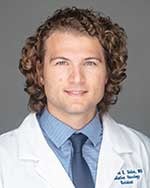 Ammoren Dohm, MD
Ammoren Dohm, MD
Ammoren is a native of rural Minnesota and the oldest of five siblings. He attended Brigham Young University where he majored in neuroscience and married his lovely wife. Together they moved to North Carolina where Ammoren attended medical school at Wake Forest and his wife completed her MHA. They recently purchased a home in Wesley Chapel and are looking forward to their time in Florida. In their free time, they enjoy traveling, hiking, beach days, tennis, pickleball, and dinner with family and friends.
Why I chose this residency program: During the interview process, I was impressed with Moffitt's leadership's clear vision and execution strategy for the Radiation Oncology Department. I wanted optimal training opportunities, and I knew Moffitt could deliver because it has been nationally ranked by U.S. News & World Report since 1999, is consistently ranked in the Top 10, is one of only 51 National Cancer Institute-designated Comprehensive Cancer Centers nationwide, and is a research powerhouse with over 450 clinical trials. I found the culture at Moffitt to be ideal for me: warm, encouraging, and ambitious. Moffitt is also geographically appealing as Tampa is one of the country’s top vacation and retirement destinations.
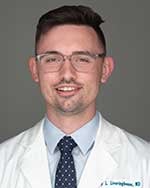 Casey Liveringhouse, MD
Casey Liveringhouse, MD
Casey Liveringhouse grew up in Plymouth, Minnesota. He attended Luther College in Decorah, Iowa, where he majored in biology. He completed medical school and his internship in internal medicine at the University of South Florida. In his free time, Casey enjoys fishing, golfing, and spending time with his son, wife, and dogs.
Why I chose this residency program: I chose to do my residency at Moffitt Cancer Center because of the collegial atmosphere and stellar reputation, both clinically and in research. As one of the NCCN Member Institutions, Moffitt combines high clinical volume with exposure to rare cancers, which provides excellent clinical training. Resources for research are abundant, with an emphasis on developing strategies for the personalization of radiation therapy, which will be increasingly important as the field of oncology evolves. Most importantly, the camaraderie between residents and faculty fosters a supportive culture where I felt like I fit in very well.
 Maria Sandoval, MD
Maria Sandoval, MD
Maria Luisa (Mari) was born and raised in Quito, Ecuador and came to the U.S. at age 18 for college. She attended Clark University in Worcester, MA then pursued a Master in Physiology at Case Western Reserve University in Cleveland, OH where she completed her thesis in breast cancer stem cell markers and their role in response to treatment. She then attended New York Medical College for medical school and completed her intern year in medicine at the University of South Florida. In her free time, she enjoys boating with her husband and dog, traveling, drawing cartoons and organizing get-togethers for friends and family.
Why I chose Moffitt: I chose to do my residency at Moffitt Cancer Center because it really encompassed all the features that I felt were essential in a program. One of the many strengths of this program was the genuinely warm and collegial atmosphere not just between residents but between attendings and residents. At Moffitt Cancer Center I have found that each attending and staff member in our department is truly committed to resident education. Additionally, as a high-volume cancer center and the only NCI-designated Comprehensive Cancer Center based in Florida, it provides an extensive breadth of opportunities for clinical training as well as abundant research opportunities. Finally, Tampa is a great place to live with many exciting indoor and outdoor activities.
Research:
- Sandoval, ML, Rosen, EB, Robert, AJ, Nelson, JA, Matros, E, Gelblum, DY. Immediate dental implants in fibula free flaps to reconstruct the mandible: A pilot study of the short‐term effects on radiotherapy for patients with head and neck cancer. Clin Implant Dent Relat Res. November, 2019; 1–5.
- Sandoval, ML, Rimner A., Lee N., Gelblum D.Y. Outcomes of patients with concurrent Head and Neck and Lung malignancies who were treated for cure with multi-modality approach. Poster presented at American Society for Radiation Oncology, Chicago, IL. September 2019
- Sandoval, ML, Yuan Z G., Grass D., Felder S., Sanchez J., Dessureault S., Imanirad I, Kim RD., Hoffe SE., Frakes JM. Impact of Sarcopenia on outcomes in patients with rectal carcinoma treated with tri-modality therapy. Poster presented at Gastrointestinal Symposium, San Francisco, CA. January 2019
- Varadan, V., Sandoval, M., & Harris, L. N. Biomarkers for Predicting Response to Anti- HER2 Agents. Advances in Experimental Medicine and Biology Novel Biomarkers in the Continuum of Breast Cancer. March, 2016; 155-167.
PGY-4
John Michael "JM" Bryant, MD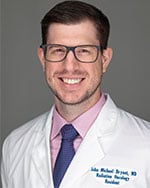
Dr. Bryant is a resident physician at the University of South Florida and the H. Lee Moffitt Cancer Center and Research Institute. A core aspect of his work is integrating innovations from electrical and computer engineering into clinical oncology practices, underscoring his belief in the transformative potential of such interdisciplinary collaboration. He's dedicated to advancing oncology treatments and has been actively involved in research on MRI-guided radiotherapy to enhance the accuracy of cancer therapies. Furthermore, he has worked on developing deep neural networks to facilitate real-time biological treatment adaptation and has focused on the potential of magnetoelectric nanoparticles as novel theragnostic agents. Beyond his clinical and research pursuits, Dr. Bryant has showcased leadership both locally and nationally. He co-leads the Canopy Cancer Collective Resident & Fellow Committee, coordinating efforts across 14 leading cancer centers, and plays a vital role in expanding the outreach of the Association of Residents in Radiation Oncology.
Why I chose this residency program: I chose Moffitt Cancer Center because of the breadth of research and clinical opportunities paired with an institutional culture that prioritizes collegiality and interdisciplinary teamwork throughout the entire center. The staff prioritizes the education and mentoring of residents along with providing significant guidance and support in resident-led research. Furthermore, the combination of Moffitt’s high clinical volume and resident autonomy offers superb clinical training for my future career.
Online adaptive MRgRT: As a medical student performing research at the Miami Cancer Institute (MCI) and resident at MCC, my primary clinical research focus has been to explore safe delivery of ablative dose escalation, re-irradiation, and daily adaptive radiotherapy for tumors located next to radiosensitive normal structures to improve the local control rates of stereotactic external beam radiotherapy.
a. Chuong MD, Bryant J, Mittauer KE, et al. Ablative 5-Fraction Stereotactic Magnetic Resonance-Guided Radiation Therapy With On-Table Adaptive Replanning and Elective Nodal Irradiation for Inoperable Pancreas Cancer. Pract Radiat Oncol. Mar-Apr 2021;11(2):134-147. doi:10.1016/j.prro.2020.09.005
b. Bryant JM, Palm RF, Liveringhouse C, et al. Surgical and Pathologic Outcomes of Pancreatic Adenocarcinoma (PA) After Preoperative Ablative Stereotactic Magnetic Resonance Image Guided Adaptive Radiation Therapy (A-SMART). Advances in Radiation Oncology. 2022;7(6)doi:10.1016/j.adro.2022.101045
c. Chuong MD, Bryant JM, Herrera R, et al. Dose-Escalated Magnetic Resonance Image-Guided Abdominopelvic Reirradiation With Continuous Intrafraction Visualization, Soft Tissue Tracking, and Automatic Beam Gating. Adv Radiat Oncol. Mar-Apr 2022;7(2):100840. doi:10.1016/j.adro.2021.100840
d. Bryant J, Palm RF, Herrera R, et al. Multi-Institutional Outcomes of Patients Aged 75 years and Older With Pancreatic Ductal Adenocarcinoma Treated With 5-Fraction Ablative Stereotactic Magnetic Resonance Image-Guided Adaptive Radiation Therapy (A-SMART). Cancer Control. 2023;30:10732748221150228. doi:10.1177/10732748221150228
DNN models for predicting clinical outcomes during radiotherapy: While performing research on online adaptive MRgRT, I have also aided in the development of proof-of-concept DNNs in and interdepartmental project involving the Departments of Radiation Oncology and Machine Learning using diagnostic imaging, daily MRIs acquired with online MRgRT, and clinical outcomes data to train several DNN models to determine if changes in tumor features during online MRgRT can predict for local and distant disease control.
a. P. Ghasemi Saghand, I. El Naqa, S. Rosenberg, J. Bryant, K. Latifi, J. Frakes, S. Hoffe, E. Moros. A Deep Learning Approach for Progression prediction using Morphological Changes in GTV During Treatment with MR-guided Radiation Therapy. 2022 Annual American Association of Physicists in Medicine (AAPM) Meeting
b. J.M. Bryant, P.G. Saghand, Kujtim Latifi, J Frakes, S Hoffe, Eduardo Moros, Kathryn E. Mittauer, Rupesh Kotecha, I El Naqa, S.A. Rosenberg. A novel multi-task hybrid deep neural network (DNN) predicts tumor progression during MRgRT. 2023 Annual European Society for Radiotherapy and Oncology (ESTRO) Meeting (Oral Presentation)
Development of MENPs as onco-theragnostic tools in a preclinical model: During my undergraduate career, I developed experience with nanofabrication at the Florida International University and the University of California at Berkeley. I have brought this experience to help develop a multi-departmental initiative to perform pilot experiments exploring MENP use as a theragnostic agent:
- High Specificity Anticancer Immune Response Treatment induced via Irreversible Electroporation with Magnetoelectric Nanoparticles in Pancreatic Cancer
- In vivo magnetoelectric nanoparticles as a tumor-targeting contrast agent for T2 magnetic resonance imaging in a murine flank tumor model
Research:
- Bryant JM, Palm RF, Liveringhouse C, et al. Surgical and Pathologic Outcomes of Pancreatic Adenocarcinoma (PA) After Preoperative Ablative Stereotactic Magnetic Resonance Image Guided Adaptive Radiation Therapy (A-SMART). Advances in Radiation Oncology. 2022;7(6)doi:10.1016/j.adro.2022.101045
- Bryant J, Palm RF, Herrera R, et al. Multi-Institutional Outcomes of Patients Aged 75 years and Older With Pancreatic Ductal Adenocarcinoma Treated With 5-Fraction Ablative Stereotactic Magnetic Resonance Image-Guided Adaptive Radiation Therapy (A-SMART). Cancer Control. 2023;30:10732748221150228. doi:10.1177/10732748221150228
- Bryant JM, Sim AJ, Feygelman V, Latifi K, Rosenberg SA. Adaptive hypofractionated and stereotactic body radiotherapy for lung tumors with real-time MRI guidance. Methods. Frontiers in Oncology. 2023-January-27 2023;13doi:10.3389/fonc.2023.1061854
- Bryant JM, Weygand J, Keit E, et al. Stereotactic Magnetic Resonance-Guided Adaptive and Non-Adaptive Radiotherapy on Combination MR-Linear Accelerators: Current Practice and Future Directions. Cancers (Basel). Mar 30 2023;15(7)doi:10.3390/cancers1507208
Ruben J. Cruz-Chamorro, MD
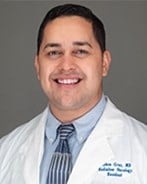 Ruben J. Cruz-Chamorro was born and raised in Ponce, Puerto Rico. He obtained a Bachelor’s degree in Biomedical Sciences at the University of Puerto Rico in Ponce. He was then accepted into Ponce Health Sciences University School of Medicine where he obtained both his Masters degree in Medical Sciences and his Doctorate in Medicine (MD). In his spare time, he enjoys songwriting, exploring new restaurants and spending time with family.
Ruben J. Cruz-Chamorro was born and raised in Ponce, Puerto Rico. He obtained a Bachelor’s degree in Biomedical Sciences at the University of Puerto Rico in Ponce. He was then accepted into Ponce Health Sciences University School of Medicine where he obtained both his Masters degree in Medical Sciences and his Doctorate in Medicine (MD). In his spare time, he enjoys songwriting, exploring new restaurants and spending time with family.
Why I chose this residency program: I chose Moffitt Cancer Center because education and training are a fundamental part of their core mission. The staff prioritizes the learning experience of residents at all times. Furthermore, the high clinical volume combined with the unlimited research opportunities makes Moffitt one of the fastest growing cancer centers in the world.
Research:
- J.R. Gunther, C. Park, B. Dabaja, S.A. Milgrom, R. J. Cruz Chamorro, L.J. Medeiros, J. Khoury, N. Garg, B. Amini, R. Steiner, R. Nair, P. Strati, J.R. Westin, H. Lee, N. Fowler, L. Nastoupil, S.S. Neelapu, C.C. Pinnix. Radiation therapy for salivary gland MALT lymphoma: ultra-low dose treatment achieves encouraging early outcomes and spares salivary function. Leuk Lymphoma. 2019; PMID: 31373240.
- C.C. Pinnix, J.R. Gunther, S.A. Milgrom, R. J. Cruz Chamorro, L.J. Medeiros, J. Khoury, B. Amini, S.S. Neelapu, H. Lee, J. Westin, N. Fowler, L. Nastoupil, B. Dabaja. Outcomes after Reduced-Dose Intensity Modulated Radiation Therapy for Gastric Mucosa-Associated Lymphoid Tissue (MALT) Lymphoma. Int J Radiat Oncol Biol Phys. 2019; PMID: 30769175.
- J.R. Gunther, C. Park, S.A. Milgrom, B. Dabaja, R. J. Cruz Chamorro, L.J. Medeiros, J. Khoury, N. Garg, B. Amini, M.A. Fanale, H. Lee, N. Fowler, L. Nastoupil, S.S. Neelapu, C.C. Pinnix. Radiation Therapy for Salivary Gland MALT Lymphoma: Ultra Low Dose Treatment Spares Salivary Function and Achieves Excellent Outcomes. Int J Radiat Oncol Biol Phys. 2018; 102(3): e244-e244.
- C.C. Pinnix, J.R. Gunther, S.A. Milgrom, R. J. Cruz Chamorro, L.J. Medeiros, J. Khoury, B. Amini, M.A. Fanale, S.S. Neelapu, H. Lee, J. Westin, N. Fowler, L. Nastoupil, B. Dabaja. Excellent Outcomes after Reduced-Dose Intensity Modulated Radiation Therapy for Gastric Mucosa-Associated Lymphoid Tissue (MALT) Lymphoma. Int J Radiat Oncol Biol Phys. 2018; 102(3): S90-90.
PGY-3
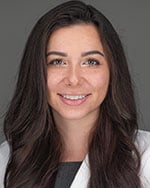 Emily Keit, MD
Emily Keit, MD
Emily was born in southern New Jersey but was raised primarily in Nebraska. She attended college at the University of Nebraska at where she studied biotechnology and chemistry. She attended medical school at University of Nebraska Medical Center. She completed her preliminary internal medicine year with University of South Florida and Moffitt. Interests outside of medicine include spending time in nature.
Why I chose this residency program: I chose to do my training at Moffitt for many reasons. First, as an NCI Comprehensive Cancer Center, there are abundant research opportunities. Moffitt fosters a collaborative research environment between clinicians of all oncologic specialties, bench researchers, and computer modeling-based researchers. There is also an emphasis here on mentorship, and leadership strives to foster residents' individual interests and passions. I was confident that I would receive excellent clinical training and have the support needed to achieve my clinical and research-based goals. Lastly, during my Internal Medicine intern year here, I was able to experience the overarching culture of Moffitt and the shared goals of providing personalized and holistic patient care. I am honored to be a part of this culture and community.
Vaseem Khatri, MD
Vaseem Khatri was born in New Jersey and raised in Rochester Hills, Michigan. He completed his undergraduate studies in Biomedical Physics at Wayne State University.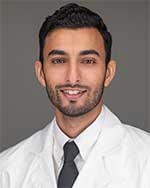 He then attended the University of Cincinnati College of Medicine, followed by a preliminary year in Internal Medicine at The Christ Hospital in Cincinnati. In his free time, he enjoys dancing, watching movies, and spending time with his beautiful wife.
He then attended the University of Cincinnati College of Medicine, followed by a preliminary year in Internal Medicine at The Christ Hospital in Cincinnati. In his free time, he enjoys dancing, watching movies, and spending time with his beautiful wife.
Why I chose this residency program: I chose Moffitt Cancer Center because it fulfilled and exceeded every expectation for a residency program. The collegiality and support between residents, attendings, and staff, as well as across disciplines creates the optimal atmosphere. The leadership and the faculty take a true interest in the development of the residents as top-tier radiation oncologists, holistic physicians, and as humans. Additionally, Moffitt Cancer Center provides exceptional clinical and research opportunities. With its high patient volume, unique case load, extensive network, and available treatment modalities, it provides comprehensive training. Moffitt is on the forefront of radiation oncology research and has abundant opportunity and resources for its residents. Finally, Tampa is an excellent place to live, with unlimited activities, stellar year-round weather, and beautiful beaches and parks.
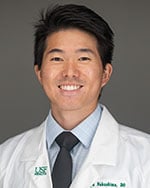 Justyn Nakashima, DO
Justyn Nakashima, DO
Justyn was born in Miami, FL and raised in Orlando, FL. He studied at the University of Central Florida majoring in Health Sciences and then attended Edward Via College of Osteopathic Medicine for medical school in Auburn, AL. He completed a preliminary medicine year at USF before starting his residency at Moffitt. In his free time, he loves to spend time with his wife and dog “Oslo”, explore new restaurants/breweries, go to the beach, play golf/soccer, go fishing, and travel.
Why I chose this residency program: I was very impressed by the abundance of research opportunities and clinical training that Moffitt offers. As a high-volume center, I knew that Moffitt would provide excellent clinical exposure and give me the opportunity to see and treat rare cancers. I was drawn to the program’s focus on personalized therapy utilized in both the clinical and research settings. The camaraderie between the residents and the resident-focused environment provided by the faculty made it an easy decision for me.
PGY-2
Dekuang “DK” Zhao, DO, PhD 
Dekuang “DK” Zhao was born and raised in China. He completed the Cancer Biology graduate program at the University of Miami. He then attended medical school at Liberty University, followed by a preliminary year in Internal Medicine at the University of South Florida. Outside of medicine, he enjoys fishing, cooking, and spending time with his family on the beach.
Why I chose this residency program: I chose this program because of its high clinical volume, forefront research opportunities and supportive learning environment. As one of the leading cancer hospitals, Moffitt provides comprehensive cancer care to diverse patient populations across the nation, which gives residents abundant clinical exposure to various treatment modalities. Building upon Total Cancer Care, current research focusing on radiosensitivity index (RSI)-driven personalized radiation opens doors for a wide spectrum of clinical trials. Lastly and most importantly, the culture of mentoring and collaboration in our program fosters an excellent environment for residents’ academic and professional development.
Research:
- Xiaoyu Jiang, XiaoQing Lu, Andrew J Gentles, Dekuang Zhao, Seth A. Wander, Yu Zhang, Yasodha Natkunam, Joyce Slingerland, Isildinha M. Reis, Brian Rabinovich, Midhat H. Abdulreda, Vincent T. Moy, Izidore S.Lossos, HGAL inhibits lymphoma dissemination by interacting with multiple cytoskeletal proteins. Blood Advances. 2021. Sep 20; bloodadvances.2021004304.
- Yanxia Ma, Jonathan Shepherd, Dekuang Zhao, Lakshmi Reddy Bollu, William M. Tahaney, Jamal Hill, Yun Zhang, Abhijit Mazumdar and Powel H. Brown. SOX9 Is Essential for Triple-Negative Breast Cancer Cell Survival and Metastasis. Mol Cancer Res. 2020, 18(12):1825-1838.
- Hyunho Yoon, Minsoon Kim, Kibeom Jang, Miyoung Shin, Alexandra Besser, Xue Xiao, Dekuang Zhao, Seth A. Wander, Karoline Briegel, Lluis Morey, Andy Minn, and Joyce M. Slingerland. p27 transcriptionally coregulates cJun to drive programs of tumor progression. Proc Natl Acad Sci U S A. 2019, 116(14):7005-7014.
- Dekuang Zhao, William M. Tahaney, Abhijit Mazumdar, Michelle I. Savage, Powel H. Brown. Molecularly Targeted Therapies for p53-mutant Cancers. Cell Mol Life Sci. 2017, 74(22):4171-4187.
- Zhao D, Pan C, Sun C, Gilbert C, Drews-Elger K, Azzam DJ, Picon-Ruiz M, Kim M, Ullmer W, El-Ashry D, Creighton CJ, and Slingerland JM. VEGF drives cancer-initiating cells through VEGFR-2/STAT3 signaling to upregulate Myc and Sox2. Oncogene. 2015, 34(24):3107-3119.
- Zhao D, Alexandra A*, Wander S, Sun J, Wang B, Ince T, Zhou W, Guo W, Mills G, Theodorescu D, Slingerland JM. Cytoplasmic p27 promotes epithelial-mesenchymal transition and tumor metastasis via STAT3-mediated Twist1 regulation. Oncogene. 2015, 34(43):5447-5459. (*Equal contribution)
- Jing Zhao, Dekuang Zhao, Graham M. Poage, Abhijit Mazumdar, Yun Zhang, Jamal L. Hill, Zachary C. Hartman, Michelle I. Savage, Gordon B. Mills, Powel H. Brown. Death-associated protein kinase 1 promotes growth of p53-mutant cancers. J Clin Invest. 2015, 125(7):2707-2720.
John Peterson, MD 
John Peterson grew up in Salt Lake City, Utah and completed both undergraduate and medical education at the University of Utah. He and his wife love exploring Tampa's cultural and culinary diversity with their baby boy.
Why I chose this residency program: It was important to me that I train at an NCI Comprehensive Cancer Center in the NCCN serving a large and diverse patient population. Moffitt is just that. I was also looking for an institution that was expanding and I wanted colleagues that were smart and supportive. While I was interacting with Moffitt residents and faculty, it was clear that this was a place that valued mutual respect, innovation, and professional development.
Research:
- Peterson JS, Plana D, Bitterman DS, Johnson SB, Aerts HJ, Kann BH. Growth in eligibility criteria content and failure to accrue among National Cancer Institute (NCI)‐affiliated clinical trials. Cancer Med. 2023; 12:4715-4724. doi:10.1002/cam4.5276
- Peterson, J, Wilson, TF, Watt, MH, et al. International medical tourism of US cancer patients for alternative cancer treatments: Financial, demographic, and clinical profiles of online crowdfunding campaigns. Cancer Med. 2023; 00:1- 9. doi:10.1002/cam4.5636
- Peterson JS, Peckham ME, Poppe MM, Burt LS, Shrieve DC, Cannon DM. Delineating the Subarachnoid Space in the Adult Lumbosacral Spine Using Computed Tomographic Myelography: An Aid for Clinical Target Volume Delineation in Craniospinal Irradiation. Advances in Radiation Oncology. 2022;7(5):100994.
- Peterson J, Wilson T, Gruhl J, et al. Timing and Motivations for Alternative Cancer Therapy With Insights From a Crowdfunding Platform: Cross-sectional Mixed Methods Study. JMIR Cancer. 2022;8(2):e34183. Published 2022 Jun 7. doi:10.2196/34183
- Peterson J, Chow C, Bonnett R, Colbert-Getz J. Improving students' narrative feedback to educators. Med Educ. 2020;54(5):477-478. doi:10.1111/medu.14122
- Hutten R, Khouri A, Parsons M, Tward A, Wilson T, Peterson J, et al. The Clinical Significance of Maximum Tumor Diameter on MRI in Men Undergoing Radical Prostatectomy or Definitive Radiotherapy for Locoregional Prostate Cancer. Clin Genitourin Cancer. 2022;20(6):e453-e459. doi:10.1016/j.clgc.2022.06.010
- Parsons MW, Hutten RJ, Tward, Khouri A, Peterson J, et al. The Effect of Maximum Tumor Diameter by MRI on Disease Control in Intermediate and High-risk Prostate Cancer Patients Treated With Brachytherapy Boost. Clin Genitourin Cancer. 2022;20(1):e68-e74. doi:10.1016/j.clgc.2021.10.003
- Peterson JS, Swire-Thompson B, Johnson SB. What is the alternative? Responding strategically to cancer misinformation. Future Oncol. 2020;16(25):1883-1888. doi:10.2217/fon-2020-0440
Radiation Oncology Residency Program
